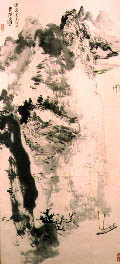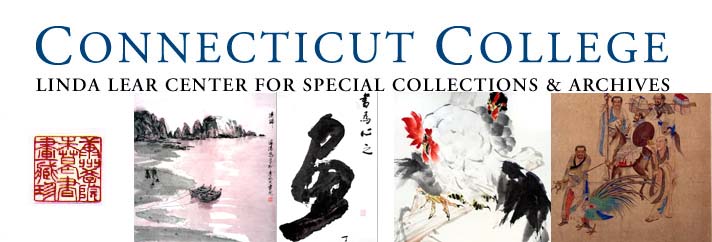Landscape Paintings
Chang Dai-chien (1899-1983)
Hanging Scroll, Ink and Color on Rice Paper, 36 x 17 in., (91.5 x 43 cm.)
 To write about Chang Dai-chein makes me feel nostalgic. I have deep respect for him. We met in the fifties and sixties whenever he came to New Haven. When they walked into the house and saw our children's doodlings on the dining room wall, Mr. Chang said loudly, "Picasso could not do better." Mr. Chang was outgoing, spirited, energetic, generous, and a man of wit and fine humor. He was everybody's friend. Fu Shen, former Associate Director at the Sackler Art Gallery of the Smithsonian Institute in Washington, called Chang a "lion among painters".
To write about Chang Dai-chein makes me feel nostalgic. I have deep respect for him. We met in the fifties and sixties whenever he came to New Haven. When they walked into the house and saw our children's doodlings on the dining room wall, Mr. Chang said loudly, "Picasso could not do better." Mr. Chang was outgoing, spirited, energetic, generous, and a man of wit and fine humor. He was everybody's friend. Fu Shen, former Associate Director at the Sackler Art Gallery of the Smithsonian Institute in Washington, called Chang a "lion among painters".
Chang Dai-chien is already a legendary figure in Chinese art history. Like the name Chi Pai-shih (1863-1957), the name Chang Dai-chien has spread far and wide. Books about this white-bearded scholarly artist are abundant. Stories about him are plentiful and many of them are hilarious. He was indeed the center of attention wherever he went; a delightful and eloquent conversationalist.
Dai-chien began as an artist in his early years. Born in a rich and educated family, he was taught to paint by his mother. After he went to high school and later to Kyoto to study for four years, be began his formal painting instruction under two Shanghai artists. Dai-chien's favorite artist, Shih Tao (1641-c.1717), was a great influence to him. Dai-chien copied Shih Tao's work and at a young age he became a connoisseur and began to collect ancient Chinese paintings. By the time the war started in 1937, he already had twenty-four boxes of treasured pieces, some of which later became his major source of income for a comfortable lifestyle abroad, in Brazil and Carmel, CA.
His first major show in Peking in 1934 was a great success. From 1941 until 1943, he painted wall murals at the Temple of 1,000 Buddhas in Tun Huang in northwestern China. His focus became bigger and wider as time went on. He was invited to show everywhere in the world. In July 1956, he was in Paris attending his own exhibition. While there, he and his wife met Picasso at his home in Cannes. Picasso showed over 20 of his paintings in the style of Chi Pai-shih and asked Chang for comment. Mr. Chang was polite but direct. He told Picasso that the tools he used were not right. Later Chang sent some Chinese brushes to Picasso. While they were chatting, Picasso told Chang Dai-chien, "What puzzles me most is why you Chinese come to Paris to learn about painting."
This landscape painting in the Chu-Griffis Art Collection at the college was painted after supper at Fred Wang's house in New Haven. We were there with them. This landscape is inscribed to me, and it was in our family for years until we gave it to help start the collection. I knew then the Chu-Griffis Collection could never afford the prices his paintings would sell for in the world market. This painting is not a serious one, but the spontaneity and personal friendship make it singularly an example of the literati pattern of painting for fun and sharing. For this it is priceless. My salutations to a man with the true heart of an artist.
This painting was donated by Charles and Bettie Chu.
